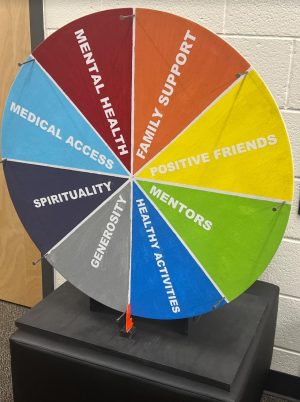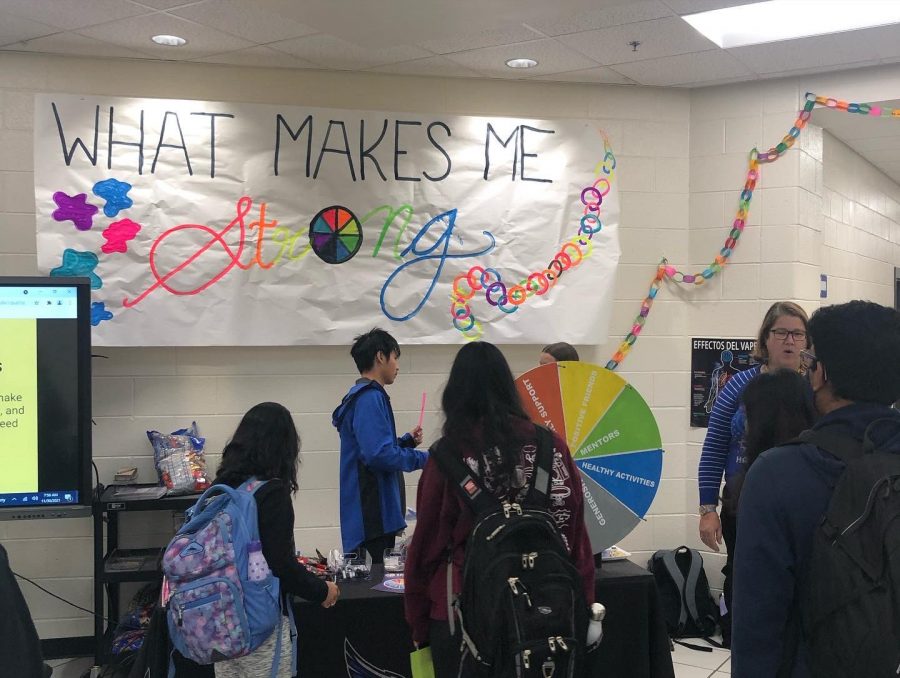SFHS Counselors Work With Students to Raise Awareness for Suicide Prevention
Used with permission from South Forsyth High School
Everyone matters. South Forsyth High School counselors and students create a new suicide awareness campaign known as Sources of Strength. Students were encouraged to spin the Sources of Strength Wheel to learn more about who they can contact in order to support their mental health needs.
December 1, 2021
A growing concern among students and staff requires attention, and thankfully, the faculty is working towards taking measures to protect its students.
This prevalent concern is suicide, which takes the lives of around 800,000 people around the world annually. A mixture of mental, physical, and social stressors during high school years may cause thoughts or attempts of suicide for young students who are still exploring and growing. Therefore, it’s important for schools to raise awareness for suicide prevention in order to protect these young lives.
The statistics regarding this topic showcase the growing prevalence and concern of suicide, especially in high school. Every year, approximately 1 out of every 15 high schoolers report having attempted suicide. To elaborate, some risk factors impacting suicide rates include family issues, societal stigma (surrounding mental health) and school stress regarding deadlines or grades.
Specifically in Georgia, in 2018 suicide was the 3rd leading cause of death in individuals aged from 15-29. There was also a 76.3% increase in suicide rates for people residing in Georgia aged 10-24 from 2016 to 2018. Furthermore, the presence of the pandemic negatively impacted suicide rates as well. For teenage girls, the Centers for Disease Control and Prevention (CDC) saw an alarming rise of 51% in suicide attempts after COVID-19 struck. These statistics not only emphasize the need for more suicide awareness information but also to accentuate the need for taking preventative action in order to decrease suicide rates in our society.
As for South Forsyth High School, suicide prevention and awareness is a major topic of concern. The counselors and administration strive to support students in times of stress and anxiety to avert any possibility of suicide; however, it’s important to recognize suicide attempts and how they affects the student population at South.
In order to put this into perspective, the slideshow below contains information from the 2020 Georgia Student Health Survey. Click through the different student reports below to learn about data specifically from SFHS students.
Suicide Prevention Infographic by Shree Delwadia
In order to take a deeper dive into this topic, South Forsyth High School’s counselors Ms. Frankel and Ms. Campobenedetto graciously elaborated on the concern and its prevention.
Importance of Awareness
“Suicide tends to be like a taboo topic people are afraid to talk about it, which isn’t helpful,” Ms. Campobennedetto said.
According to mental health professionals, suicide is preventable if individuals are aware of the corresponding risk factors or warning signs. Specifically, some signs can include feelings of isolation, anger, hopelessness, withdrawal, or death. In order to prevent attempts or thoughts of suicide, the community must work together and take initiative. With further awareness, students are able to assist their peers and start the right conversation to seek proper help.
Ms. Campobennedetto said, “it’s treatable, just like any other condition. [For] someone who has diabetes, it’s treated with insulin and any [other condition], you treat it too, so it’s just an important thing [to consider] and also just talk about.”
The matter of suicide is not one to be taken lightly or kept secret. It’s important to put in the effort needed in order to protect these young lives. Therefore, helping the student body recognize the relevance of this topic and its impact on mental health is key to preventing suicide.
Warning Signs
Additionally, the counselors made sure to address the topic of suicide warning signs. Being aware of these warning signs is instrumental in taking the best precautions to prevent the suicide of loved ones. With this knowledge, students are able to identify when to take the proper steps if someone is feeling down or not their usual self. Working towards fighting suicide is a community effort, highlighting how students, teachers, and faculty must work together to spread awareness and support.
One major sign is depression, a constant feeling of overwhelming sadness and angst shadowing someone, affecting their behavior in many ways.
Ms. Campobennedetto explains that generally, people associate depression with sadness, but in many ways, it can also be represented through anger for adolescents specifically.
Everyone goes through cranky periods where they just aren’t having the best day, but she emphasizes that “if it persists, that’s something to look for.”
Some more common warning signs that an individual should be on the lookout for include drinking alcohol and taking drugs at a young age, being distant and disconnected from the rest of the world, and lying in many situations.
Moreover, the pressures and demands of schoolwork combined with a student’s personal and social life are major reasons why some people turn to taking their own lives. While this is not the complete list of warning signs for suicide, it’s important to remember that suicide impacts each person differently. To learn more about these warning signs, please click here.
When an individual notices a friend or loved one withdrawing from their relationships and acting in unusual ways compared to their normal selves, it is important to take action. Looking out for depression and other related mental health conditions would aid in preventing drastic consequences such as suicide.
Prevention
Fortunately, there are a variety of ways individuals can receive help when they face hardship such as having thoughts or attempts of suicide. Most importantly, individuals should always reach out to a trusted adult to receive professional help to bring them out of this state. However, in many situations, when a friend or relative is feeling down, they refuse to get help. If you confront them and they still don’t want to go see someone, then you can ask them if they want to go see a trusted adult or professional with you.
To help someone in this situation, Ms. Campobenedetto discusses the ACT formula.
“[For the A] acknowledge that you’re noticing changes and you’re noticing certain behaviors in your friend,” said Ms. Campobenedetto. “The C stands for care, meaning communicating to them that you care about them. And then, the T represents tough. Go with them [a friend] to tell her [a trusted adult], especially if you know they’re not on board with them.”
This process may seem hard, but it could save a loved one’s life, so it is vital to act upon ACT and take the necessary steps, even if it’s against the individual’s wish.
Furthermore, there are many other online platforms and resources to help individuals in crisis. First, there is a National Suicide Prevention Lifeline that could help anyone in need. Simply texting the number and talking to them could get anyone access to professional help.
Additionally, the Suicide Prevention Lifeline offers many options to help individuals cope such as finding a support group, developing a safety plan, and joining different events that relate to an individual’s situation. This lifeline includes many stories of “hope and recovery” to showcase to those struggling that they are not alone despite how difficult their personal fight might be.

Another action SFHS’s counselors are excited to introduce is the “Sources of Strength” campaign. Sources of strength are areas or people of support for students in need, and they include the following aspects: physical health, mental health, family support, positive friends, mentors, healthy activities, generosity, and spirituality.
The purpose of this wheel is to help students work proactively as they find their “source of strength” in a moment of weakness to prevent any suicidal thoughts or attempts.
Ms. Frankel further elaborates on the purpose, saying, “When you’re feeling low, you can choose something on the wheel and learn about the different parts of it.”
If you can’t find something or someone in your life that connects to one of these values, then you can focus on fixing that area and finding that strength through help to regain your happiness.
Fundamentally, although student suicide is a growing concern, there are many ways to fight back against it. Taking the steps and measures to make sure everyone feels loved and important in this world is necessary in order to prevent suicide.





